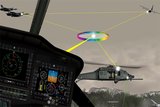Hughes and VNC team to offer extended mobile communications
Hughes Network Systems and Virtual Network Communications (VNC) have launched a new offering that will extend mobile network connectivity, using an integrated combination of VNC's deployable long-term evolution technology with Hughes’ Jupiter and HM satellite systems.
This new combination will be offered to support various applications, including for government, militaries, first responders, and commercial mobile network operators.
‘We're excited to work with Hughes to help expand high speed 4G services cost-effectively in under-served parts of the world, as well as providing the tactical edge for military and first responders,’ Mohan Tammisetti, CEO of VNC, said.
‘VNC developed this innovative, edge-centric approach to positively impact lives and keep critical missions connected. Additionally, a new 5G solution is on our development roadmap and we look forward to integrating it with the Hughes Jupiter platform.’
For government and military customers, this is designed to provide wireless coverage for soldiers or first responders, while integrating the new Hughes HeloCell system with VNC's LTE technology and the Hughes HeloSat system can provide beyond line of sight communications on rotary-wing aircraft.
The Hughes and VNC technologies combine to form an ‘airborne cell tower’ when installed aboard a helicopter or an unmanned aerial vehicle, which provides an extended cellular coverage radius of tens of kilometres, with the satellite terminal backhauling the mobile traffic to and from the network core.
This system can also scale to support more than 100 simultaneous active users on a single, layered system architecture.
‘Adaptable for rotary-wing aircraft and UAVs, the HeloCell solution is ideal for extending mobile connectivity in a disaster area or warzone,’ Wayne Marhefka, senior director of business development for the Hughes Defense division, said.
‘Together with VNC, Hughes can extend connectivity to soldiers and first response teams who need wireless communications to carry out their missions, especially in remote and disconnected environments. Integrating with our innovative HM and Jupiter systems technology, these new cellular capabilities will help the DoD build a layered and unified communications network architecture for faster and more-informed decision-making.’
More from Five Eyes Connectivity Special Report
-
![Podcast: Five Eyes Connectivity - Canada]()
Podcast: Five Eyes Connectivity - Canada
In this episode of the Five Eyes Connectivity podcast, we look at the unique situation faced by Canada and how its military is responding to a rapidly changing world.
-
![Podcast: Five Eyes Connectivity - Australia and New Zealand]()
Podcast: Five Eyes Connectivity - Australia and New Zealand
In this episode of the Five Eyes Connectivity podcast, we hear how two of the smaller militaries in the Five Eyes alliance – Australia and New Zealand – are responding to a rapidly-changing world.
-
![Podcast: Five Eyes Connectivity - The United Kingdom]()
Podcast: Five Eyes Connectivity - The United Kingdom
In this episode of the Five Eyes Connectivity podcast, we hear how a rapidly shifting threat environment is driving a transformation of British military capabilities.
-
![Podcast: Five Eyes Connectivity - The United States]()
Podcast: Five Eyes Connectivity - The United States
In this episode of the Five Eyes Connectivity podcast, we dive into the connectivity issues facing the US military and its further development of the Multi-Domain Operations concept.
-
![Australian CHORUS is on song]()
Australian CHORUS is on song
The Australian Department of Defence announced on 11 May that it is exploring ways to integrate laser-based optical and RF communication technologies onto a single …
-
![Tactical data link provider expects major new order this month]()
Tactical data link provider expects major new order this month
Looking to the future of the Multifunctional Informational Distribution System Joint Tactical Radio System (MIDS JTRS), BAE Systems expects an imminent new production contract and …

























